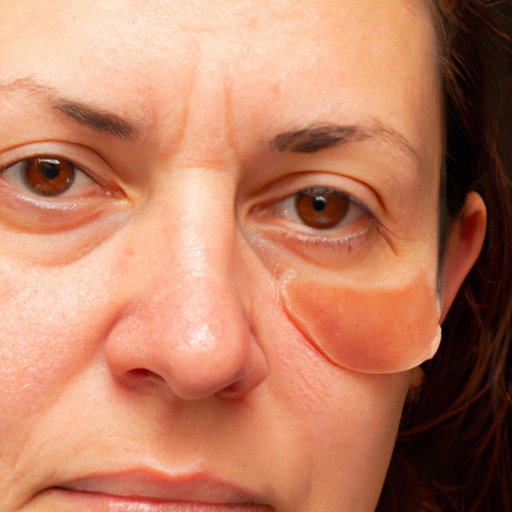
Introduction
Have you ever experienced a painful, red bump on your eyelid? It could be an eye stye, a common condition caused by an infection of the oil glands in the eyelid. While styes are usually harmless and go away on their own, they can be uncomfortable and irritating. In this article, we will explore effective ways to get rid of an eye stye, including home remedies, medical treatments, prevention tips, and more.
Home Remedies
One of the most effective ways to treat an eye stye is by using home remedies. Here are a few popular ones:
- Warm compress: Apply a warm compress to the affected area for 10-15 minutes, 3-4 times a day. This can help reduce pain and swelling by increasing blood circulation and preventing bacteria growth.
- Tea tree oil: Mix a few drops of tea tree oil with a carrier oil like coconut or olive oil and apply it to the stye using a cotton swab. Tea tree oil has antimicrobial properties that can help kill the bacteria causing the infection.
- Aloe vera: Cut a fresh aloe vera leaf and extract the gel. Apply the gel to the stye and let it sit for 15-20 minutes before rinsing it off with lukewarm water. Aloe vera has anti-inflammatory properties that can help reduce redness and swelling.
- Other natural remedies: Some other natural remedies include turmeric powder, castor oil, and green tea bags.
While using natural remedies, it’s important to keep a few precautions in mind. Make sure you’re not allergic to any of the ingredients, and avoid applying anything directly to your eye. Always use a cotton ball or swab to apply the remedy, and make sure to clean your hands before doing so.
Medical Treatments
If your eye stye doesn’t go away on its own within a week or gets worse, it’s important to see a doctor. Here are a few medical treatments that can help:
- Antibiotics to reduce inflammation: Your doctor may prescribe antibiotics in the form of eye drops, ointments, or pills to help reduce inflammation and kill bacteria.
- Surgery to completely remove the stye: In rare cases, your doctor may recommend surgery to drain the stye if it’s particularly large or painful.
- Other medical treatments: Other treatments like steroid injections or oral medications may also be recommended depending on the severity of the stye.
Prevention
Preventing eye styes is important in maintaining proper eye health. Here are a few preventative tips:
- Maintaining cleanliness: Wash your hands regularly and avoid touching your eyes with dirty hands. Clean your face and eyes regularly with a gentle cleanser.
- Avoiding sharing personal items: Do not share towels, pillowcases, or other personal items with anyone else to prevent the spread of bacteria.
- Wearing protective eyewear: If you’re working in a dusty environment or around chemicals, wear protective eyewear to prevent eye irritation.
- Other prevention tips: Eating a healthy diet, getting enough sleep, and managing stress can also help keep your immune system strong and prevent eye infections.
Foods to Avoid
Certain foods can aggravate an eye stye and make it worse. Here are a few foods to avoid:
- Junk food: Junk food can weaken your immune system and make it harder for your body to fight off infections.
- Processed foods: Processed foods are often high in sugar and can cause inflammation, which can worsen eye styes.
- Spicy foods: Spicy foods can irritate the eyes and cause further inflammation.
Instead, try to eat a healthy and balanced diet with plenty of fruits, vegetables, and proteins. Drinking plenty of water can also help flush out toxins and keep your body hydrated.
Hygiene Tips
Good hygiene is crucial in preventing eye styes. Here are a few hygiene tips:
- Regular hand-washing: Wash your hands regularly with soap and warm water to prevent the spread of bacteria.
- Keeping the eyes clean: Use a warm, damp cloth to gently clean your eyelids and remove any excess oil or dirt.
- Other hygiene tips: Avoid rubbing your eyes, do not wear eye makeup when you have a stye, and replace your eye makeup regularly.
Types of Styes
There are two types of styes: external and internal.
- External styes: External styes, also known as hordeolum, occur when an infection affects the hair follicles or sweat glands of the eyelids. They appear as a red bump or pimple on the outside of the eyelid and can be painful to the touch.
- Internal styes: Internal styes occur when the infection affects the oil-producing glands inside the eyelids. They appear as a painful bump or swelling on the inside of the eyelid and can cause blurred vision or sensitivity to light.
Treatment options for both types of styes include warm compresses, antibiotics, and surgical removal in severe cases.
Conclusion
Eye styes can be uncomfortable and irritating, but they can be effectively treated with home remedies, medical treatments, and preventative measures. Maintaining good hygiene, eating a healthy diet, and avoiding sharing personal items can help prevent eye styes. If you’re experiencing a stye, try using warm compresses, tea tree oil, or aloe vera. If your stye doesn’t improve after a week or gets worse, consult a doctor who may prescribe antibiotics or recommend surgery. It’s important to take good care of your eyes to prevent eye styes and maintain proper eye health.





